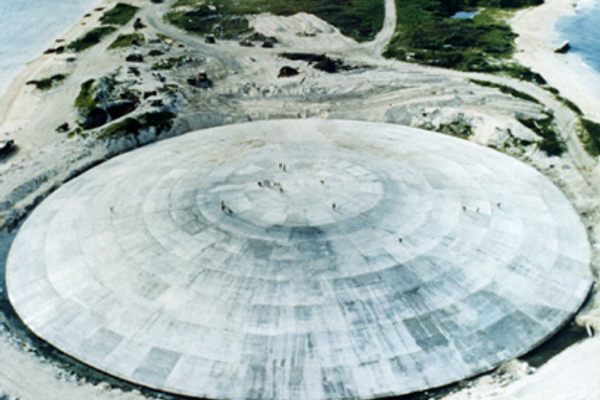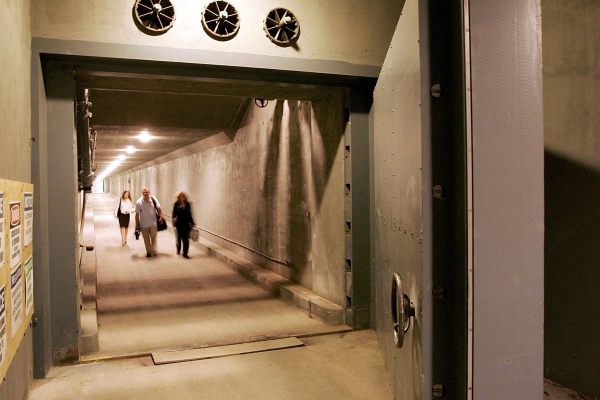How a Converted Auto Shop in San Francisco Became a Hub for Cold War Diplomacy

3220 Sacramento St., today (Photo: Will Kreth/Wikimedia)
From the outside, 3220 Sacramento Street looks unremarkable. A low, wide building in San Francisco’s quiet but wealthy Presidio Heights neighborhood, on a street known for its concentration of psychologists, psychiatrists and psychoanalysts, 3220 was once an auto shop. In its heyday, the first floor was often full of cars.
Upstairs, though, starting in the 1980s, an informal collective of activists and dreamers, brought together by the heir to a toy company, were trying to change the world.
The Apple Multimedia Lab had its offices here. There were environmental groups and parapsychology groups, working alongside the astronauts of the Association for Space Explorers. The San Francisco Tesla Society (devoted to the promotion of science, not the future car) held meetings in the penthouse. The building was a hub of the 1980s citizen diplomacy movement, which aimed to end the Cold War by connecting everyday people in the Soviet Union and America. There was a giant dish on the roof, capturing TV transmissions meant for Moscow audiences. On New Year’s Eve, the penthouse would host an intercontinental party, connecting the world’s two great superpowers by a “slow-scan” video link.
Perhaps most famously, the first commercial email system connecting the U.S. and the Soviet Union was established in this same building.
The Sacramento Street structure might best be described as an informal think tank, created and funded by a single person, Henry Dakin. He preferred to blend into the background of the place he had created—he once introduced himself to a Congressional delegation as the building manager—but he held the key to its existence and provided the office space, the technology and the money that made 3220 possible
“He created an intellectual center, which was missing from San Francisco,” says Anya Kucharev, who worked at 3220 on citizen diplomacy and is creating an archive documenting the movement’s work. “This was more sophisticated counter culture.”

The 3220 crowd, on the roof (Photo: Courtesy of Max Aguilera-Hellweg)
At times, some more traditional signifiers of San Francisco weirdness (a crystallographer, a woman dressed as a butterfly) might show up. But 3220 also had some of the most sophisticated computers and printing technology available at the time. They had, for instance, a printer that could transfer computer-edited images to film, that would then be developed on the on-site dark room. Dakin loved technology, and the first time Joel Schatz met him, he was under a table, with no shoes on, wiring a computer.
Schatz had an appointment, to ask for money, on the recommendation of another funder. The way Schatz tells the story, the conversation went simply.
“Don thought you might be interested in giving me some financial support,” Schatz said.
“Ok,” replied Dakin. “How much do you want?”
Schatz asked for $5,000. Dakin wrote the check and crawled back under the table. Schatz asked if he wanted to know what the money was for.
“Not now, I’m busy,” Dakin replied.
A few days later, they met again, and Schatz explained the purpose of the project—to create a commercial electronic mail link between the Soviet Union and California. Once he heard the actual idea he had already began funding, Dakin gave Schatz an office, furniture, equipment, and a grant to hire more people.
Meetings with Dakin often went like this. When Kim Spencer went to track down the director of the Esalen Institute’s Soviet-American program at Sacramento Street, he instead met Dakin, who ended up funding one of Spencer’s TV projects, on the nuclear arms race. Soon, Spencer and his wife, Evelyn Messinger, were working out of 3220, too.
Dakin’s money came in part from his connection to Dakin, Inc., a company founded by his father and brother, which had become the largest stuffed toy company in the world. “A lot of people really liked it that Henry was a teddy bear of a man, and his money came from selling the first commercial teddy bears,” says Ed Ellsworth, who worked for many years on technical support at 3220 and founded his organization Dolphin Net there.

A Dakin teddy bear (Photo: Courtesy of FluffyFlowers/Etsy)
California-born, Dakin had gone to Harvard and come back west to work at the Lawrence Berkeley Lab. In 1966, the year he turned 30, his family was in a plane crash and his father and brother were among his seven relatives who were killed.
After the crash, in the 1970s, Dakin started spending time at his office on Washington Street, just three blocks from 3220, digging deeper into parapsychology and starting to support underground newspapers in the Soviet Union. It was at Washington Street that Schatz first met him, but already he was at work renovating 3220 to house an expanding network of citizen diplomacy groups. Over time, Dakin would buy up still other buildings in the neighborhood, as the family of 3220 grew too big for its quarters.
That first Sacramento Street building was still the epicenter, though—the penthouse, in particular, when 3220 events were hosted. Dakin would set up chairs, fire up the sound systems, and carry in catered food, and there was a big outdoor deck and a view of the San Francisco skyline. “It became a place that important people would want to rent out, because it had developed this aura of an incomprehensibly powerful space, in this residential area of San Francisco,” says Schatz.
One New Year’s, the group that gathered in the penthouse, in anticipation of video chatting, ‘80s-style, with Moscow, included the singer Bobby McFerrin, the poet Lawrence Ferlinghetti, the cartoonist Bill Griffith, the chemist and Nobel Laureate Glenn Seaborg, and a Japanese reggae band, with a seven-foot-wide gong. The connection to Moscow never even went through, but the party made papers on both sides of the Iron Curtain. Schatz remembers seeing out Bobby McFerrin, to his “beat-up jalopy,” as the singer said good-bye to the Nobel prize winner with a slap on the hand and—”Catch you later, Seaborg.”
The work going on at 3220, though, was also at the center of world affairs, as the Iron Curtain fell. The Esalen Soviet-American Program was bringing high-level Soviet officials to the U.S., and Gorbachev’s chief economic adviser stopped by 3220 on his visit. The New York Times, Stanford, Harvard, even the Library of Congress, were using Schatz’s email link to communicate with their counterparts in the Soviet Union. “Time was spending $50,000 a month to connect to their databases in New York City so their journalists could access them,” Schatz says. And in 1991, during a brief putsch in the Soviet Union, that attempted to wrest control of the country from Gorbachev, some of the only information coming out of Moscow was coming through 3220 and the network of citizen diplomats Dakin had supported.
3220 Sacramento Street worked much like today’s San Francisco tech incubators, and many of the organizations that started there eventually moved out as they grew. A decade ago, San Francisco University High School bought the building, and today it serves as the school’s “South campus.”
Dakin himself died in 2010, and Vergilia Dakin, his wife, and Laura Drewes, are now working to collect 3220 stories (send them to [email protected]) from the 30-year period that Dakin filled it with people. And there are so many stories for them to collect: 3220 was one of those places that, at a particular time, had a kind of magic to them, that lingers.















Follow us on Twitter to get the latest on the world's hidden wonders.
Like us on Facebook to get the latest on the world's hidden wonders.
Follow us on Twitter Like us on Facebook